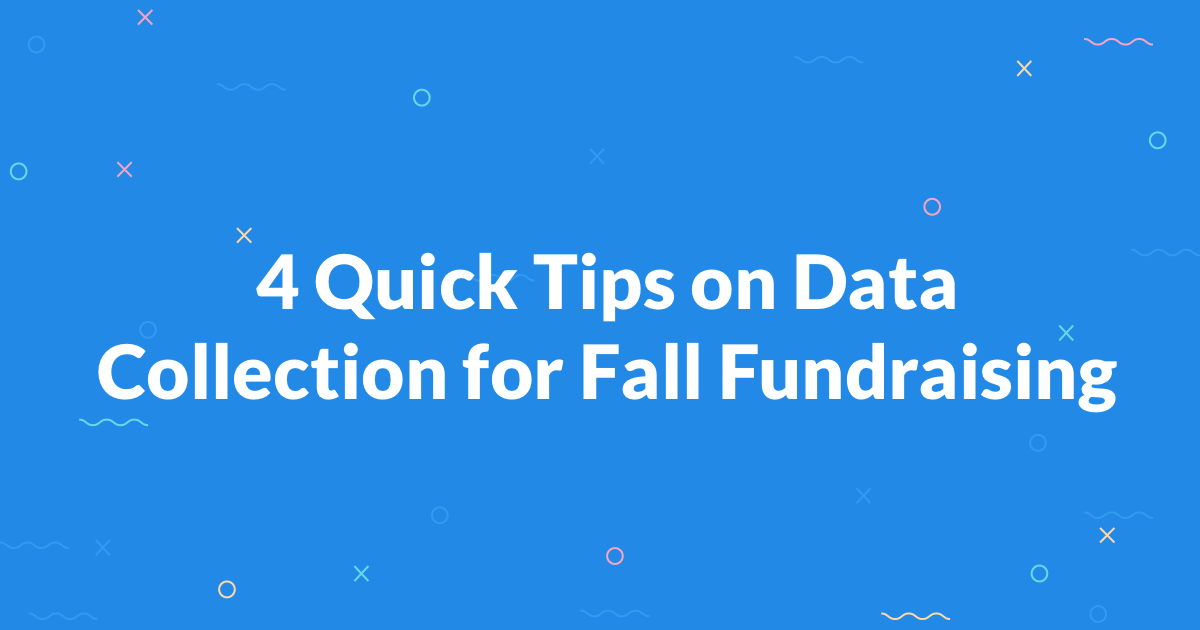4 Quick Tips on Data Collection for Fall Fundraising

Meaningful data drives meaningful action, and when asked, 85% of nonprofits report that “technology is the key to their success of their organizations.” Yet, many nonprofits state that measuring data and implementing new technology themselves are challenging tasks. With #GivingTuesday in sight, you might be asking how to best collect and use your performance data to inform your Year-End strategy. In this blog post, we’ll offer 4 key tips on data collection to set your nonprofit up for success when it comes to tracking campaign performance and informing critical campaign decisions.
1. Monitor email engagement rates
Do you ever wonder if you are sending too many emails? Or maybe too few? These reasonable concerns about email come up often around #GivingTuesday and Year-End. However, it’s important to keep in mind that there’s no universally recommended number of emails to send. The right volume is determined by whether your audience wants to keep hearing from you, which is reflected based upon their level of engagement with your emails. Combining critical data to drive informed decisions with specific, effective tools leads to successful outcomes.
Keeping track of basic metrics for email like opens, clicks, and unsubscribes helps nonprofits identify the health of their email files. Low open rates can indicate problems with deliverability and spam. High unsubscribe rates can indicate list fatigue. If these rates are generally consistent from one message to next there’s generally no need to worry, but keep an eye out for changes.
2. Monitor email performance and benchmark year-over-year (YOY)
While it might sound obvious to do, monitoring email performance and benchmarking every year are crucial steps to take both during and after the process. Having agility and flexibility are important when it comes to making tweaks and changes right when the need arises. Recording time-bound results (i.e. 24-hour or 48-hour statistics) on email sends can make all the difference when it comes to understanding and analyzing data.
A 24-hour stat is the collection of email performance data roughly 24 hours after each send. What are the benefits of this practice? With 24-hour stats, you can compare performance directly year over year. This means being able to compare the immediate performance after an email launches to a previous year without having to wait for complete data since most emails have a tail where revenue will trickle in over several days. This gives an immediate pulse on performance, which can help inform future messaging.
3. Optimize the performance of your website and donation forms
Understanding website and donation form performance is critical to successful fall fundraising. But what does this mean, exactly? It can be intimidating to think about the technical aspects of websites and donation forms, so here are three key elements to help guide performance optimization.
Site speed
How fast does your website load? Does the form render in a short amount of time? This factor matters because it drastically impacts the experience of your visitor and potential donor, and whether they choose to continue interacting with your website.
Mobile optimization
M+R reported that half of all nonprofit website visits came from mobile in 2019, mobile click-through rates outperformed other digital channels, and mobile audiences grew for many organizations. Make sure that your websites and forms are mobile optimized so you’re not losing important traffic and conversions.
Friction and errors
Friction is when there are common frustration points on your website that cause visitors to leave or fail to convert. From HTTP failures to issues with metadata, website errors also act as barriers to optimization and driving visitor engagement.
If digital optimization is an area in which your organization is looking to improve, EveryAction Digital Services may be able to help, with custom websites, email templates, online forms, technical support, and private training for nonprofits looking for an upgrade or even just for something new.
4. Engage and track your donors across channels
Nonprofits often only think about email sends when it comes to a traditional digital program, and for good reason. A lot of revenue is still directly attributed to email, but at the same time, more and more donors aren’t reachable by email. Active email subscribers do contribute about 42% of online revenue, but not all of that revenue is attributed to email.
What does that all mean? Chances are your supporters aren’t on just one channel. In the digital-dominant world we live in, we switch channels like we switch web browser tabs, going from one to the other to get us closer to wherever it is that we’re trying to go. An omni-channel approach helps nonprofits make sure they can get in effectively front of donors and supporters and meet them where they are, wherever they are, and whenever the time is right.
Looking for more info on how your nonprofit can leverage data to drive more donations, maximize donor relationships, and do more good? Watch our webinar, “Data and Donors: #GivingTuesday & Year End AMA with M+R” to get the in-depth insight from trusted experts in the world of data and nonprofits.


